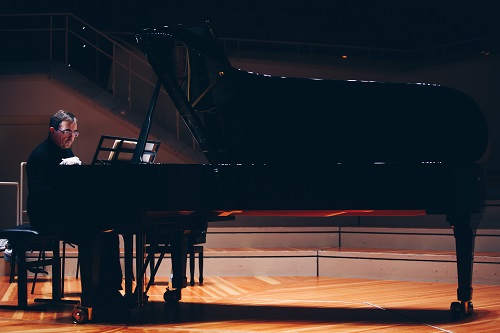
 Germany Musikfest Berlin 2018 [10] – Stockhausen: Pierre-Laurent Aimard (piano), Kammermusiksaal, Philharmonie, Berlin, 3.9.2018. (MB)
Germany Musikfest Berlin 2018 [10] – Stockhausen: Pierre-Laurent Aimard (piano), Kammermusiksaal, Philharmonie, Berlin, 3.9.2018. (MB)

Stockhausen: Klavierstücke III, IV, II, I, V, VIII, VII, VI, XI, IX, X
I have no doubt that memories of hearing Pierre–Laurent Aimard play the first eleven Stockhausen Klavierstücke will remain with me forever: like hearing Maurizio Pollini in Chopin or Daniel Barenboim in Beethoven. Not so much a performance of the year as of a lifetime, this recital proved just as all-encompassing and arguably still more necessary. Certainly no one present would have been left doubting or denying, in what would have been his ninetieth-birthday-year, Stockhausen’s demand to be heard alongside those and other past masters.
First came the first four, in the order III, IV, II, and I: almost, but not quite the order of composition (III, II, IV, I). The third is not only the shortest of the Klavierstücke but the shortest of all Stockhausen’s compositions. We hear – chez Aimard, we certainly heard – not only Webern enthroned but Webern instrumentalised: the Webern of that celebrated ‘productive misunderstanding’, conscious or otherwise, of what we still just about cling to as an idea of ‘Darmstadt’ or ‘the post-war avant garde’. What I heard immediately was a tone, a general approach to performance I recognised from having Aimard’s Art of Fugue ten years ago. Then I mused that he had, to my fascination if not always to my (irrelevant) liking, been playing Bach through the ears of Darmstadt; this seemed to confirm that. (I should now very much like to hear his Art of Fugue again.)
The fourth Klavierstück sounded both similarly and as a response. Already my ears – and, I am sure, the ears of the audience more generally – were adjusting, hearing by virtue of Aimard’s outstanding performance the relationship between all musical parameters not only set before us but dramatised. This Stockhausen was an heir to many, but was without doubt a Teutonic heir to the Messiaen of the second of the Quatre études de rhythme, ‘Mode de valeurs et d’intensités’: that extraordinary, in many ways quite atypical (for the composer), first essay in ‘total serialism’. Any lingering Romantic doubts would instantly have been silenced. Can, for instance, dynamic contrast be ‘expressive’ if it is non-negotiable? Of course: all we need do is listen. Stockhausen’s music revealed itself – or rather, was revealed by Aimard – as sonorous architecture in time just as much as Beethoven’s.
Building of voices in the second Klavierstück seemed again to have some points of correspondence with a Bach fugue: only superficially, though, for this was no one other than Stockhausen. And yet, the sense of variables as heard in ‘traditional’, earlier music continued to grow in Aimard’s performance of the first: interacting, converging, just as they would in Bach or Beethoven, alongside a ‘new’ understanding of them, perhaps long since forgotten, as musical ‘parameters’. Its emphatic final note, sustained, reverberating seemed to ask: is this a climax, a reconciliation, something new? Perhaps more important, it also seemed to ask whether such questions, such Romantic remnants retained any meaning.
Number five came fifth. In Aimard’s hands, it opened as if a ‘Jimbo’s Lullaby’ for the fifties, albeit with none of Debussy’s equally challenging vagueness. Such precise, magical variation in reverberation was not the least ‘expressive’ device to be heard here. Intervallic listening – a remnant of Webern? – will perhaps always throw up some oddities; a leaning upward minor sixth suddenly suggested to me the opening of Tristan. But that is hardly an issue unique to this music; and, in any case, why not? Furthermore, one is not listening to such intervals in isolation. Context is crucial, however ‘context’ may be considered. The eighth proved jaw-droppingly different in character, the contrast between what I heard as metre and its bending suggestive of a reinvention of rubato, both ironic and utterly sincere, unquestionably hard-won.
The seventh sounded with particular force as a response to other music: both heard here and elsewhere, perhaps even Boulez’s Second Sonata. The opening repetitions of C-sharp, always with different resonance, offered somehow a focus on something both comprehensible and incomprehensible. (Is that not the case with any music worth our time?) No one listening to Aimard’s performance could doubt the constructivism at work here that seemed somehow to blossom into something strangely akin to a reinvention of the sonata principle. Perhaps not entirely coincidentally, I started to hear intimations of Liszt. The first half closed with the sixth Klavierstück, which struck, at least to my ears, a note of defiant struggle, both traditional, even Romantic, and not. By now, the piano was sounding more and more as an instrument reinvented, our very experiences and ideas of sound and listening having been transformed. Somewhere, perhaps, in this aural penumbra were the seeds of Stockhausen’s more overt later mysticism. And yet, this remained music as generative, as dialectical as Beethoven. Intensity of work and performance alike had become close to unbearable; time, then, for a drink.
The second half opened with the eleventh Klavierstück. Rightly or wrongly, I very much felt here that typical ‘after the interval’ reinvigoration. These things matter, however much Stockhausen may (justly) have disdained our traditional concert-going practices. It was certainly not a negative thing: pitches, intervals sounded renewed in themselves rather than hermeneutically. Did the hoary Romantic idea of ‘absolute music’ have life in it yet? There were flashes of a not un-Boulezian frenzy and fury to be heard, though the architecture could hardly have been more different. I started to think of material, even poetic contrasts between swirling, serial constellations in the sky and something more traditionally, even harmonically grounded. Rotation was the thing here, I think, although I could not explain why. Poetic control, a related idea, was the one that came to me in the ninth. It was evocative – but surely of ‘itself’. What a sense of drama it nevertheless possessed. Not the first but certainly the most grievous of the evening’s telephonic interventions blighted a good few of the closing seconds.
For the tenth and final piece, Aimard put on his fingerless gloves. He and Stockhausen taught us once again, even more thoroughly than before, to re-listen – even before the truly shocking physical, musical drama of those celebrated cluster glissandos. It was not so much difficult to credit that there were only two hands – two arms, really – playing as difficult not to credit that there were not twenty. Two ears certainly seemed insufficient to listen with; alas, that was all I had. Radical hardly seemed the word; again, it was all I had. Something quite extraordinary happened during the piece’s course: through the swirling cauldron contents of cluster reverberation, a world was put (back) together. Order out of chaos? Once again, this music, these performances reached back to Bach and beyond, and forward to Stockhausen’s own Licht dramas. As I said, the performance of a lifetime.
Mark Berry